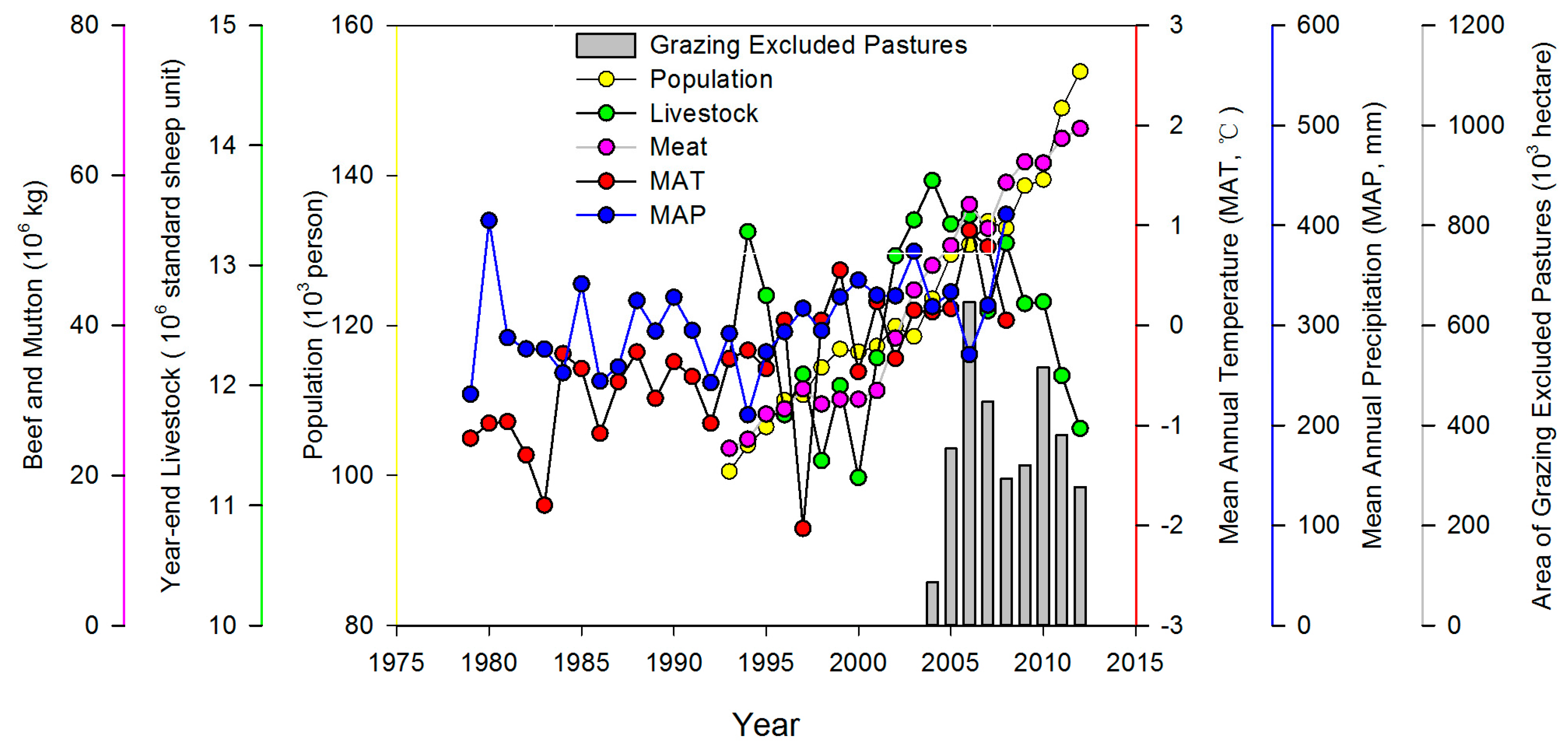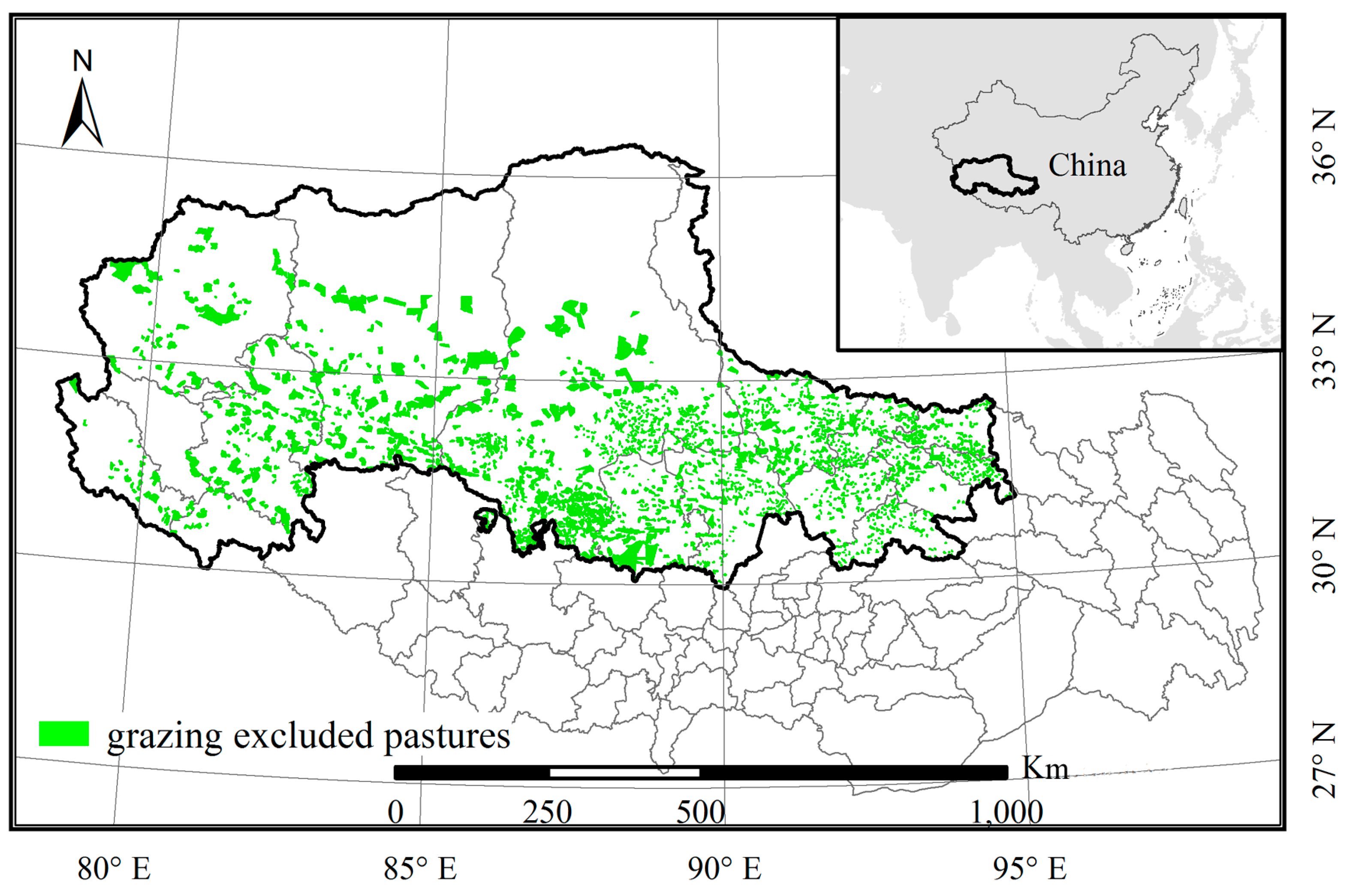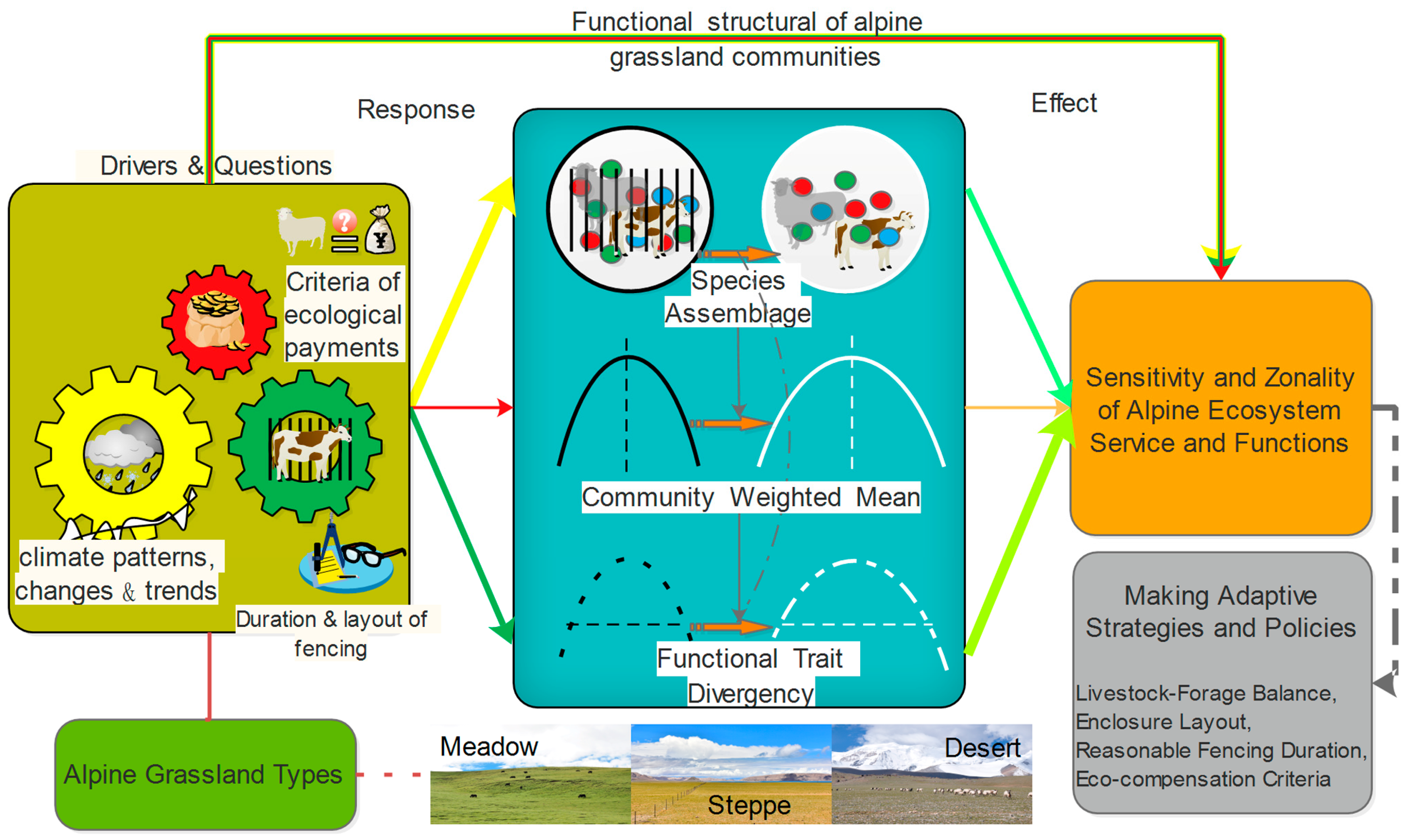Grazing Exclusion to Recover Degraded Alpine Pastures Needs Scientific Assessments across the Northern Tibetan Plateau
Abstract
:1. Climate Changes and Husbandry Development in Tibet
2. Fence Construction and Compensatory Payment Policies
3. Current Assessments on Short-Term Grazing Exclusion
4. Scientific Assessment Workflows Are Recommended
Acknowledgments
Author Contributions
Conflicts of Interest
References
- Yao, T.; Thompson, L.G.; Mosbrugger, V.; Zhang, F.; Ma, Y.; Luo, T.; Xu, B.; Yang, X.; Joswiak, D.R.; Wang, W.; et al. Third Pole Environment (TPE). Environ. Dev. 2012, 3, 52–64. [Google Scholar] [CrossRef]
- Qiu, J. The Third Pole. Nature 2008, 454, 393–396. [Google Scholar] [CrossRef] [PubMed]
- Tibet Autonomous Region Bureau of Statistics, Tibet General Team of Investigation under the NBS. Tibet Statistical Yearbook 2015; China Statistics Press: Beijing, China, 2015. [Google Scholar]
- Wu, J.S.; Zhang, X.Z.; Shen, Z.X.; Shi, P.L.; Yu, C.Q.; Song, M.H.; Li, X.J. Species richness and diversity of alpine grasslands on the Northern Tibetan Plateau: Effects of grazing exclusion and growing season precipitation. J. Resour. Ecol. 2012, 3, 236–242. [Google Scholar]
- Yan, Y.; Lu, X.Y. Is grazing exclusion effective in restoring vegetation in degraded alpine grasslands in Tibet, China? PeerJ 2015, 3, e1020. [Google Scholar] [CrossRef] [PubMed]
- Wu, J.S.; Shen, Z.X.; Zhang, X.Z.; Shi, P.L. Biomass allocation patterns of alpine grassland species and functional groups along a precipitation gradient on the Northern Tibetan Plateau. J. Mt. Sci. 2013, 10, 1097–1108. [Google Scholar] [CrossRef]
- Wu, J.S.; Shen, Z.X.; Shi, P.L.; Zhou, Y.T.; Zhang, X.Z. Effects of grazing exclusion on plant functional group diversity alpine grasslands along a precipitation gradient on the Northern Tibetan Plateau. Arct. Antarct. Alp. Res. 2014, 46, 419–429. [Google Scholar] [CrossRef]
- Wu, J.S.; Zhang, X.Z.; Shen, Z.X.; Shi, P.L.; Yu, C.Q.; Chen, B.X. Effects of livestock exclusion and climate change on aboveground biomass accumulation in alpine pastures across the Northern Tibetan Plateau. Chin. Sci. Bull. 2014, 59, 4332–4340. [Google Scholar] [CrossRef]
- Wu, J.S.; Shen, Z.X.; Zhang, X.Z. Precipitation and species composition primarily determine the diversity-productivity relationship of alpine grasslands on the Northern Tibetan Plateau. Alp. Bot. 2014, 1, 13–25. [Google Scholar] [CrossRef]
- Lu, X.; Yan, Y.; Sun, J.; Zhang, X.; Chen, Y.; Wang, X.; Cheng, G. Short-term grazing exclusion has no impact on soil properties and nutrients of degraded alpine grassland in Tibet, China. Solid Earth 2015, 6, 1195–1205. [Google Scholar] [CrossRef]
- Wu, J.S.; Zhang, X.Z.; Shen, Z.X.; Shi, P.L.; Xu, X.L.; Li, X.J. Grazing-exclusion effects on aboveground biomass and water-use efficiency of alpine grasslands on the Northern Tibetan Plateau. Rangel. Ecol. Manag. 2013, 66, 454–461. [Google Scholar] [CrossRef]
- Xiong, D.P.; Shi, P.L.; Sun, Y.L.; Wu, J.S.; Zhang, X.Z. Effects of grazing exclusion on plant productivity and soil carbon, nitrogen storage in alpine meadows in northern Tibet, China. Chin. Geogr. Sci. 2014, 24, 488–498. [Google Scholar] [CrossRef]
- Sun, J.; Wang, X.; Cheng, G.; Wu, J.; Hong, J.; Niu, S. Effects of grazing regimes on plant traits and soil nutrients in an alpine steppe, Northern Tibetan Plateau. PLoS ONE 2014, 9, e108821. [Google Scholar] [CrossRef] [PubMed]
- Harris, R.B. Rangeland degradation on the Qinghai-Tibetan plateau: A review of the evidence of its magnitude and causes. J. Arid Environ. 2010, 74, 1–12. [Google Scholar] [CrossRef]
- Chen, B.X.; Zhang, X.Z.; Tao, J.; Wu, J.S.; Wang, J.S.; Shi, P.L.; Zhang, Y.J.; Yu, C.Q. The impact of climate change and anthropogenic activities on alpine grassland over the Qinghai-Tibet Plateau. Agric. For. Meteorol. 2014, 189, 11–18. [Google Scholar] [CrossRef]
- McGill, B.J.; Enquist, B.J.; Weiher, E.; Westoby, M. Rebuilding community ecology from functional traits. Trends Ecol. Evol. 2006, 21, 178–185. [Google Scholar] [CrossRef] [PubMed]
- Violle, C.; Navas, M.L.; Vile, D.; Kazakou, E.; Fortunel, C.; Hummel, I.; Garnier, E. Let the concept of trait be functional! Oikos 2007, 116, 882–892. [Google Scholar] [CrossRef]
- Díaz, S.; Noy-Meir, I.; Cabido, M. Can grazing response of herbaceous plants be predicted from simple vegetative traits? J. Appl. Ecol. 2001, 3, 497–508. [Google Scholar] [CrossRef]
- De Bello, F.; Lepš, J.A.N.; Sebastià, M.-T. Predictive value of plant traits to grazing along a climatic gradient in the Mediterranean. J. Appl. Ecol. 2005, 42, 824–833. [Google Scholar] [CrossRef]
- De Bello, F.; Lepš, J.; Sebastià, M.-T. Variations in species and functional plant diversity along climatic and grazing gradients. Ecography 2006, 29, 801–810. [Google Scholar] [CrossRef]
- Niu, K.C.; Zhang, S.T.; Zhao, B.B.; Du, G.Z. Linking grazing response of species abundance to functional traits in the Tibetan alpine meadow. Plant Soil 2010, 330, 215–223. [Google Scholar] [CrossRef]
- Garcia, C.; Schellberg, J.; Ewert, F.; Bruser, K.; Canales-Prati, P.; Linstadter, A.; Oomen, R.J.; Ruppert, J.C.; Perelman, S.B. Response of community-aggregated plant functional traits along grazing gradients: Insights from African semi-arid grasslands. Appl. Veg. Sci. 2014, 17, 470–481. [Google Scholar] [CrossRef]
- Saatkamp, A.; Römermann, C.; Dutoit, T. Plant functional traits show non-linear response to grazing. Folia Geobot. 2010, 45, 239–252. [Google Scholar] [CrossRef]
- Banegas, N.; Albanesi, A.; Pedraza, R.; Dos Santos, D. Non-linear dynamics of litter decomposition under different grazing management regimes. Plant Soil 2015, 393, 47–56. [Google Scholar] [CrossRef]
- Grace, J.B.; Adler, P.B.; Stanley Harpole, W.; Borer, E.T.; Seabloom, E.W.; Stevens, C. Causal networks clarify productivity-richness interrelations, bivariate plots do not. Funct. Ecol. 2014, 28, 787–798. [Google Scholar] [CrossRef]
- Valencia, E.; Maestre, F.T.; Le Bagousse-Pinguet, Y.; Quero, J.L.; Tamme, R.; Börger, L.; García-Gómez, M.; Gross, N. Functional diversity enhances the resistance of ecosystem multifunctionality to aridity in Mediterranean drylands. New Phytol. 2015, 206, 660–671. [Google Scholar] [CrossRef] [PubMed]
- Körner, C. Alpine Plant Life: Functional Plant Ecology of High Mountain Ecosystems; Springer: Berlin, Germany, 2003. [Google Scholar]
- Woodroffe, R.; Hedges, S.; Durant, S.M. To fence or not to fence. Science 2014, 344, 46–48. [Google Scholar] [CrossRef] [PubMed]
- Luo, Z.; Jiang, Z.; Tang, S. Impacts of climate change on distributions and diversity of ungulates on the Tibetan Plateau. Ecol. Appl. 2015, 25, 24–38. [Google Scholar] [CrossRef] [PubMed]



© 2016 by the authors; licensee MDPI, Basel, Switzerland. This article is an open access article distributed under the terms and conditions of the Creative Commons Attribution (CC-BY) license (http://creativecommons.org/licenses/by/4.0/).
Share and Cite
Yu, C.; Zhang, X.; Zhang, J.; Li, S.; Song, C.; Fang, Y.; Wurst, S.; Wu, J. Grazing Exclusion to Recover Degraded Alpine Pastures Needs Scientific Assessments across the Northern Tibetan Plateau. Sustainability 2016, 8, 1162. https://doi.org/10.3390/su8111162
Yu C, Zhang X, Zhang J, Li S, Song C, Fang Y, Wurst S, Wu J. Grazing Exclusion to Recover Degraded Alpine Pastures Needs Scientific Assessments across the Northern Tibetan Plateau. Sustainability. 2016; 8(11):1162. https://doi.org/10.3390/su8111162
Chicago/Turabian StyleYu, Chengqun, Xianzhou Zhang, Jing Zhang, Shaowei Li, Chunqiao Song, Yuzhi Fang, Susanne Wurst, and Jianshuang Wu. 2016. "Grazing Exclusion to Recover Degraded Alpine Pastures Needs Scientific Assessments across the Northern Tibetan Plateau" Sustainability 8, no. 11: 1162. https://doi.org/10.3390/su8111162
APA StyleYu, C., Zhang, X., Zhang, J., Li, S., Song, C., Fang, Y., Wurst, S., & Wu, J. (2016). Grazing Exclusion to Recover Degraded Alpine Pastures Needs Scientific Assessments across the Northern Tibetan Plateau. Sustainability, 8(11), 1162. https://doi.org/10.3390/su8111162







